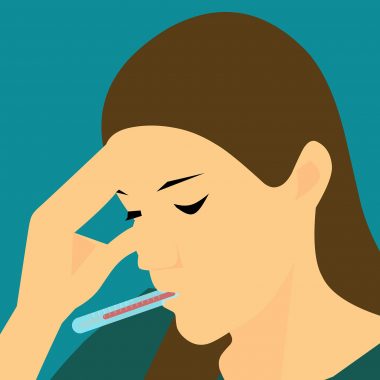The COVID-19 disease |  |
This is a new curriculum. We are refining the materials and teaching support according to teacher feedback. If you have any questions or comments, please use the contact form on the Get Help page and we will respond promptly. Thanks for your patience and understanding!
Lesson 3.1
How does SARS-CoV-2 cause disease?
This lesson focuses on how SARS-CoV-2 infects cells by attaching to its ACE2 receptor, the important role that ACE2 normally plays in homeostasis, and what happens when SARS-CoV-2 interferes with that function.
Lesson Objectives
By the end of the lesson, you will be able to…
- Explain the role of epithelial cells in SARS-CoV-2 infections.
- Describe the peptides and enzymes in the angiotensin converting system and predict symptoms based on alterations in the levels of the system’s components.
- Explain ACE2 levels in aging and disease and how this might affect SARS-CoV-2 symptoms and outcomes.
3.11 Where viral infections cause symptoms (8 slides)
How can we account for the symptoms that viral infection causes? In this short introductory section, you’ll review why different infections cause different symptoms.
3.12 The importance of epithelial cells in viral infections (9 slides)
The outside of the body is swarming with pathogens, while the inside is sterile. In this section, you’ll learn about how important epithelial cells are in forming a barrier to protect the inside from the outside.
3.13 How are epithelial cells infected with SARS-CoV-2? (12 slides)
Recall that the receptor for SARS-CoV-2 (and SARS-CoV-1) is called ACE2. Here you’ll learn where ACE2 is located and why it’s important, as well as what happens when SARS-CoV-2 infects epithelial cells.
3.14 How does ACE2 affect homeostasis? (23 slides)
You’ve learned that SARS-CoV-2’s receptor, ACE2, is located throughout the body, and plays a critical role in homeostasis. How? Here you’ll explore how ACE2 works, and what goes wrong when it’s inactivated.
3.15 How does SARS-CoV-2 affect ACE2? (24 slides)
ACE2 is critically important for blood pressure homeostasis, but what happens after SARS-CoV-2 infection? Here you’ll learn about how SARS-CoV-2 inactivates ACE2, and what happens if an infection occurs when ACE2 is already not working properly.
3.16 Why controlling Angiotensin II is important (18 slides)
In this section, you’ll learn about how drugs have been used to control the high levels of Angiotensin II found in disease. You’ll consider and answer the question: “If I’m taking these drugs, am I more likely to have a bad outcome in COVID-19?”
3.17 Vocab review
3.18 Apply your new knowledge!
Read the following news article about ACE2’s role in COVID-19 and answer the questions on your reading worksheet.
The link is here.
Documents
3.18 Reading worksheet
Lesson 3.2
SARS-CoV-2 and the immune system
This lesson focuses on how the innate immune system contributes to the symptoms encountered in COVID-19.
Lesson Objectives
At the end of this lesson you will be able to:
- Explain how the innate immune system responds to viruses
- Explain how SARS-CoV-2 interferes with the innate immune system
- Explain how a cytokine storm causes symptoms of COVID-19
3.21 What causes COVID-19 symptoms? (6 slides)
Only some of the symptoms of COVID-19 are caused by the virus itself and its receptor. The immune system response also has serious effects. In this section you’ll find out how!
3.22 How COVID-19 Kills: Acute Respiratory Distress Syndrome (ARDS) (17 slides)
ARDS is one of the most severe and often fatal symptoms of COVID-19. Here you’ll learn how ARDS occurs through a combination of tissue damage and immune response.
3.23 Symptoms of immune system activation (19 slides)
You’ve looked at how the innate immune system contributes to ARDS, but in fact, it is responsible for many symptoms of infection. In this section, you’ll learn how the process of inflammation is key to many of those symptoms, and how SARS-CoV-2 affects many other organs.
3.24 How the innate immune system responds to SARS-CoV-2 (34 slides)
In the last section, you learned that inflammation is a normal immune system response to infection. Now, you’re going to learn how the innate immune system responds to SARS-CoV-2.
You can take a break after slide 22!
3.25 The virus and the host cell dance! (32 slides)
You’ve learned how the innate immune system rapidly swings into action to eliminate a SARS-CoV-2 infection. In this section, you will learn how the defense sometimes fails. In a process we still don’t fully understand, the immune system fails to shut itself off and the tissue damage that results often leads to death.
You can take a break after slide 23!
3.26 From SARS-CoV-2’s Point of View (2 slides)
Here’s an opportunity to get creative with your new knowledge!
3.27 Vocab review
3.28 Apply your new knowledge!
Check out the following article about how young people are experiencing cytokine storms after SARS-CoV-2 infection and answer the questions on your reading worksheet.
You can find the link here.
Documents
3.26 From SARS-CoV-2’s Point of View
3.28 Reading worksheet
Lesson 3.3
Is COVID-19 only a lung disease?
This lesson focuses on how COVID-19 affects multiple organ systems and has chronic effects.
Lesson Objectives
By the end of the lesson, you will be able to…
- Describe the wide-ranging symptoms of SARS-CoV-2 on impacted organs, and how COVID-19 has chronic effects.
- Describe the role of helper proteases in SARS-CoV-2 infection and make predictions about whether SARS-CoV-2 will be able to infect certain types of cells.
- Design an experiment to determine whether or not SARS-CoV-2 infects certain types of cells.
3.31 COVID-19 Symptoms (4 slides)
What are the symptoms of COVID-19? Prepare to be surprised!
3.32 Why does SARS-CoV-2 infection cause such broad effects? (24 slides)
You’ve learned how COVID-19 is caused by a combination of ACE2 effects and the immune response to viral infections. Here you’ll focus on the symptoms of COVID-19 that indicate it’s a multi-organ disease.
3.33 COVID-19 as a chronic disease (17 slides)
COVID-19 is often compared to influenza. But while you can catch influenza more than once, it isn’t a chronic disease. COVID-19 is a chronic disease, frequently in younger patients. Here you’ll learn how.
3.34 Is ACE2 enough for efficient infection? (13 slides)
You’ve learned that cells need to have the ACE2 receptor to be vulnerable to SARS-CoV-2, but that’s not the whole story. In this section, you’ll learn about the extra help SARS-CoV-2 needs to infect efficiently and what that means for which tissues are vulnerable.
3.35 The $64K Question! Design an Experiment (30 slides)
In this section, you’re going to design and experiment to answer the $64K question. What is the $64K question? Let’s find out!
You can take a break in the middle of this section.
3.36 Case Studies (5 slides)
You’ll end this section exploring some case studies about the unusual symptoms associated with COVID-19. Choose two of the three and answer the questions on the doc your teacher will provide.
3.37 Vocab review
3.38 Apply your new knowledge!
Read the following news article about how obesity makes COVID-19 outcomes in young people worse, and complete your reading worksheet. You can find the article here.
Documents
3.36 Case Studies Questions
3.38 Reading worksheet


